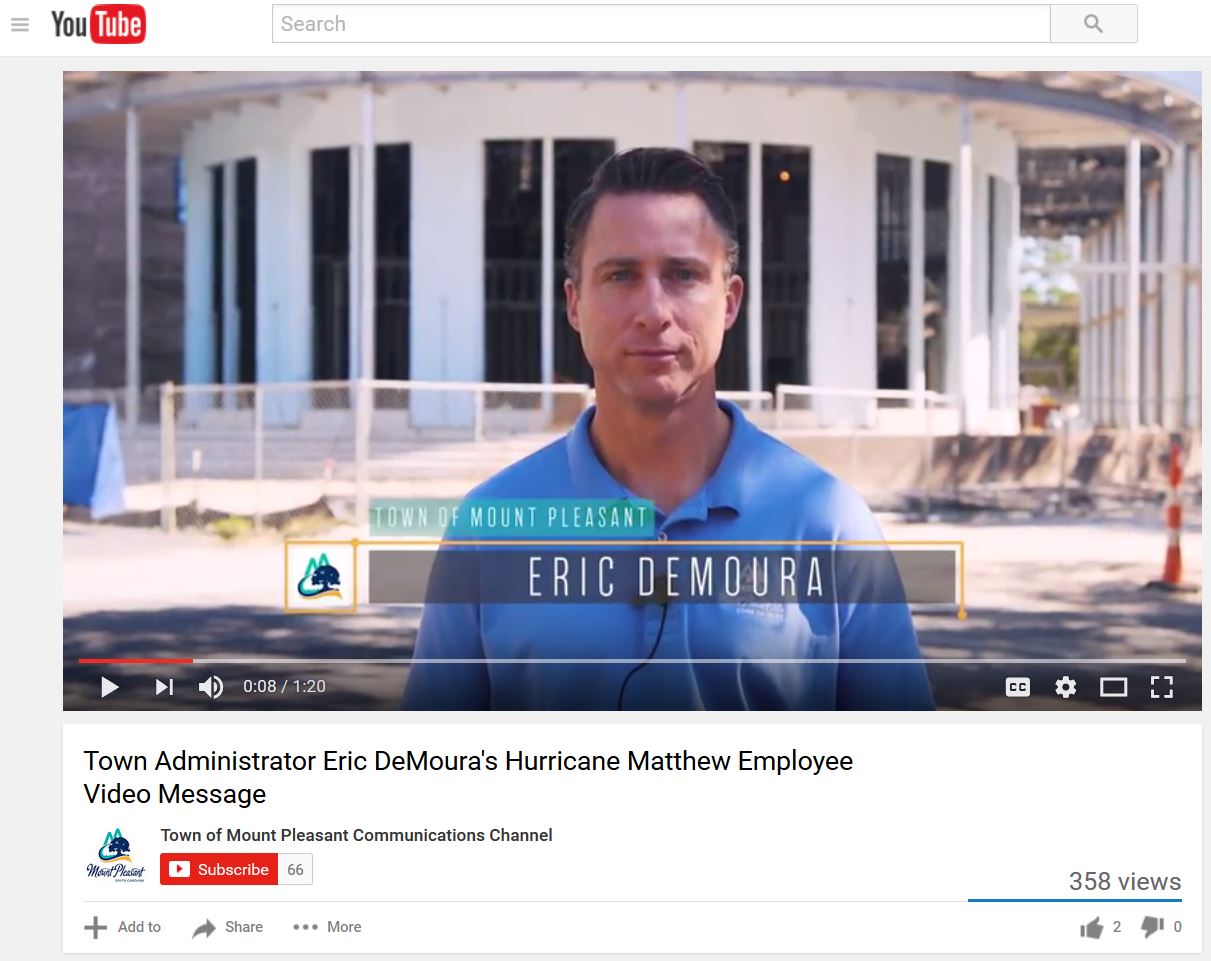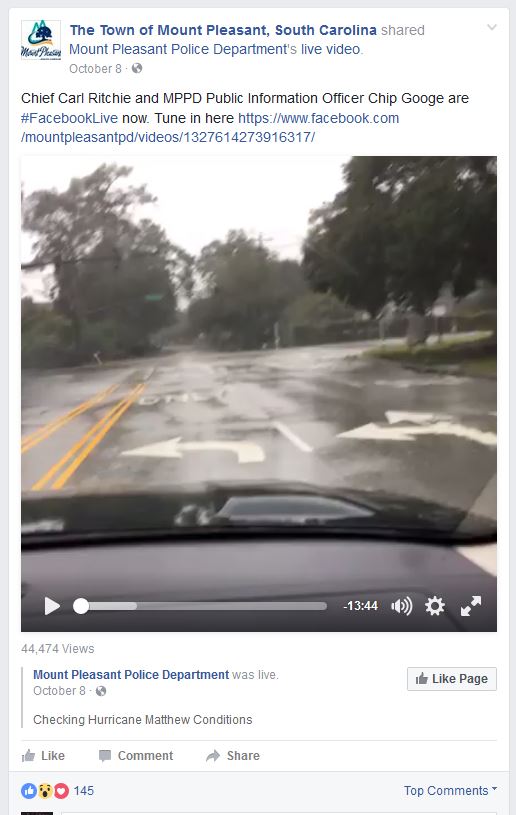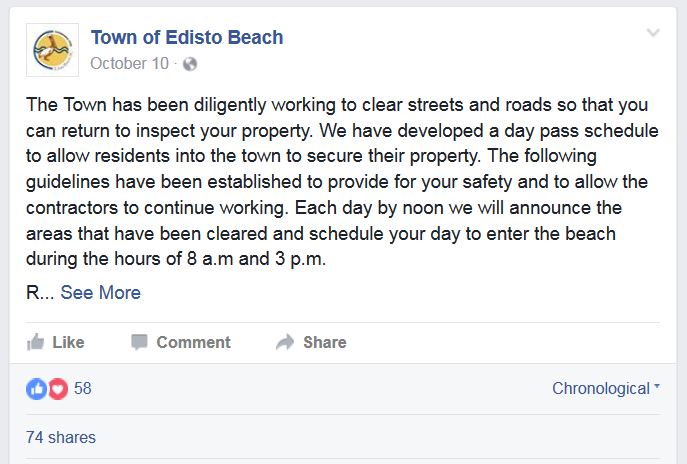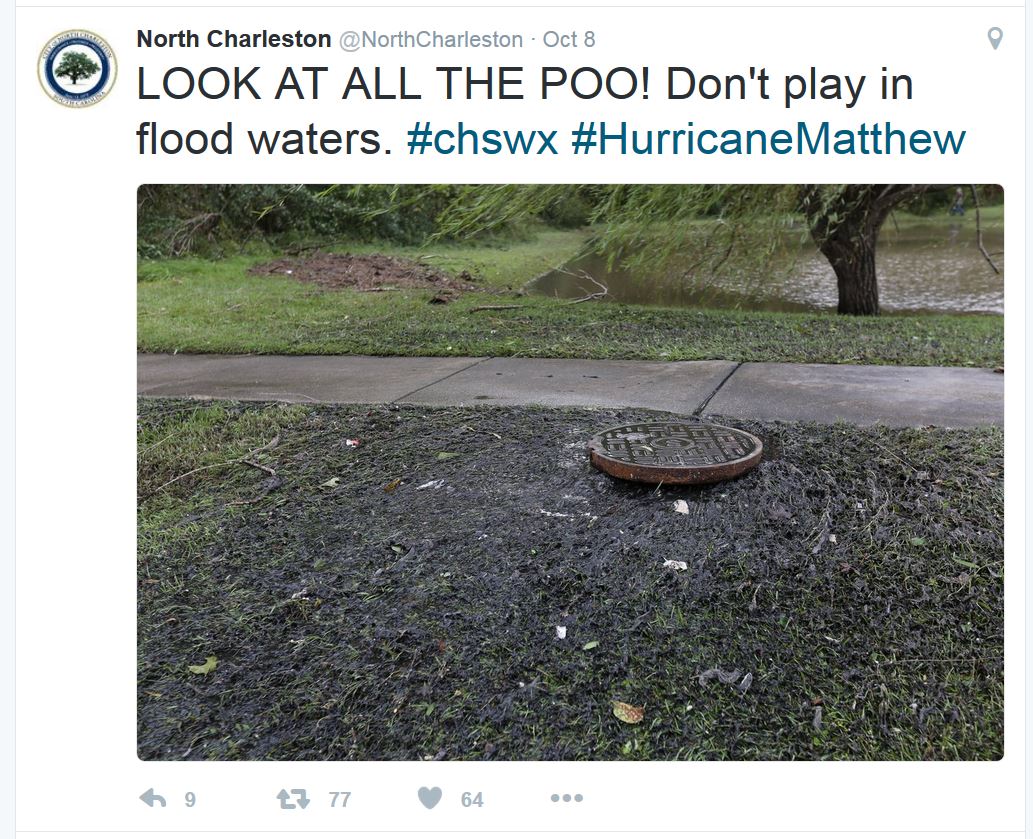As Hurricane Matthew approached the South Carolina coast in October, Bluffton Mayor Lisa Sulka appeared on a Facebook video imploring residents to evacuate. Over the coming days, she, the town manager and police chief continued to post videos to social media updating residents about the storm.

"Social media was really our lifeline," said Joy Nelson, community relations manager for the Bluffton Police Department. "Knowing how the public keeps track of social media on their phones, we were able to constantly update the public on where to go, what to do and what type of damage was done to Bluffton afterwards."
In addition to using social media, Bluffton officials used a free phone application called MyPD, which allows users to receive text alerts about important information, Nelson said. During the storm, the police and town websites were continually updated with information. The town also used Nextdoor, which started out as a neighborhood networking site and has expanded to government agencies. Whenever Nelson posted information on Facebook and Twitter, she also posted to Nextdoor.
The Town of Mount Pleasant used Nextdoor, Twitter, Facebook, its blog, and its smartphone app as the main outlets for information, according to Chip Googe, police inspector, public information officer and social media manager for the Mount Pleasant Police Department.
"Each of these platforms was crucial in helping us communicate with our community," Googe said.
One popular post was a Facebook Live video that the chief of police recorded as he drove around town looking for damage and flooding. The video received more than 70,000 views. Town Administrator Eric Demoura delivered a message of thanks on YouTube to all who assisted the community during the storm. The International City/County Management Association featured his video on its website and tweeted it to the organization's nearly 13,000 Twitter followers.
Straight from the source
Disseminating accurate information quickly is crucial when it comes to keeping a community informed during a critical event such as Hurricane Matthew, said Marquel Coaxum, multimedia coordinator for the Town of Mount Pleasant. Social media allowed the town to provide the community with accurate information straight from the source.

A primary downside to social media, however, is the same as its upside, Coaxum said. Just as accurate information can be disseminated quickly, so too can inaccurate information. Without an immediate correction, this can create a barrier to effective communication between local government and the community.
"It's exciting to be piloting a new age of communication where we take more value in the two-way street of communication with our community over the one-way street of information dissemination without feedback," Coaxum said. "We encourage our community to use social media to communicate with us. We take pride in involving and engaging our community through social media, because public service matters and community matters to the Town of Mount Pleasant."
One of the benefits of social media during emergency situations is the ability for recipients to retweet or share, said Isle of Palms City Administrator Linda Tucker. This is true of both residents sharing with one another, and with news media outlets retweeting and sharing. It's an efficient way to reach large numbers of people, Tucker said.
Facebook has become an invaluable tool to get information to residents, property owners and visitors, said Town of Edisto Beach Municipal Clerk Deborah Hargis, who is in charge of social media.

Hargis said she started posting weather forecasts about the looming hurricane on October 3. As the storm got closer, she began updating more frequently. Once the storm hit on October 8 and pictures became available, she posted remotely from her evacuation site. When residents were allowed back and streets began to open, she also posted those updates along with information from FEMA and recovery videos from the National Guard.
Triple the 'likes'
It's clear that social media had an impact, Hargis said. The town reached almost 700,000 people during three weeks in October. The town's Facebook page "likes" went from 2,000 to 6,000 during the same time frame, she said.
"It has been a time consuming process, but if it helps our residents and absentee property owners feel better about their property, and it keeps everyone safe, I'm all for it," Hargis said.
Edisto Beach Mayor Jane Darby also used Facebook to share the plight of another city hit hard by the hurricane. Her heartfelt post on her personal Facebook page brought attention to the small inland town of Nichols and the devastation that occurred there.
"I knew flooding had occurred in other parts of our state, but I had been so involved in our recovery that I was ignorant of the depth of loss of some rural towns," she posted shortly after the storm. "I talked with the mayor of Nichols tonight and almost could not talk for choking back the tears."
The City of North Charleston works hard to be proactive on social media, said Ryan Johnson, public relations and economic development coordinator.
Twitter is most effective because it gets the message out immediately, plus members of the media uses Twitter heavily, Johnson said. Facebook is good, he said, but because of its algorithms, people may not always see these posts immediately.
During the storm, city officials were in the municipal emergency operations center around the clock and any information that had to get out immediately was pushed on Twitter. After the storm, they blasted tweets about debris pickup and damage.

One tweet that grabbed a lot of attention was a photo of an overflowing sanitary sewer with the caption, "Look at all the poo! Don't play in flood waters." The tweet came about when Johnson was out surveying the effects of the storm. He thought the image of the sewer offered the perfect illustration of the dangers but also presented an opportunity for some humor.
"Municipal accounts can be so dry and boring, and nobody pays attention," Johnson said. "It helps to be a real person, add some GIFs (animated image or short video) and images."
Often in municipalities, there is a desire to control the message from the top down. Social media is a different animal, he said.
"There's got to be a certain level of trust and efficiency in a social media manager," he said. "You have to be nimble and react in an appropriate manner without a vast amount of oversight."
Johnson worked to put out a daily digest every day on Facebook. It offered helpful information that people saw and reshared, he said. Whenever possible, he linked the messages to high quality imagery like pictures of crews collecting debris.
"You're doing more than getting out information," Johnson said.
"You're telling a story."
